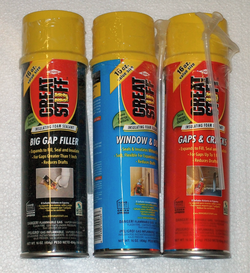How to Remove Spray Foam Insulation From Hands
Whether minimally expansive, for use around windows and doors, or maximum expansion for filling large voids and wall cavities, applying DIY spray foam insulation is a messy procedure. Most applicators would rather invest in a cheap pair of painter's coveralls, latex gloves, safety goggles and a respirator, in order to avoid getting spray foam on them. In this article, I describe how to remove it from your hands and skin.
|
1. Avoid prolonged exposure to Acetone. Acetone will soften and remove uncured foam insulation from your skin. Acetone, a highly flammable solvent, should never be used near sparks or open flames (cigarettes included)! Use harsh chemical solvent sparingly, since they will dry out your skin. Wash thoroughly with hot soapy water.
2. Scrape foam off with a fingernail or a stiff bristle brush once it has cured. Then, scrub with pumice soap and hot water. 3. Wait it out. Cured spray foam insulation will eventually wear itself off, after several days. Tips * "Goo Gone" also contains Acetone, less expensive and comes in smaller sizes. * I recommend that you apply a lotion containing Aloe, after using any solvent, to hydrate your skin. This will also help reduce irritation. * The window and door formulation is minimal expansion which will not deform your framework and cause binding. * Window and Door spray foam works well as adhesive for attaching Styrofoam board to most surfaces. * Don't forget that any foam insulation exposed to the elements needs to be primed and painted to prevent deterioration! Warnings * As mentioned above, in case it was overlooked, Acetone is highly flammable. Respect it! * Acetone must be used in a well ventilated area. * From the warning label: "Reports have associated repeated and prolonged exposure to solvents with neurological and other physiological damage." * If redness or swelling persists, consult your physician as you are likely having an allergic reaction. Reactions are usually mild, unless you have sensitive skin and are susceptible to rashes (contact dermatitis). Copyright 12/16/2008 All Rights Reserved. Questions? Comments? Contact Me |
|

